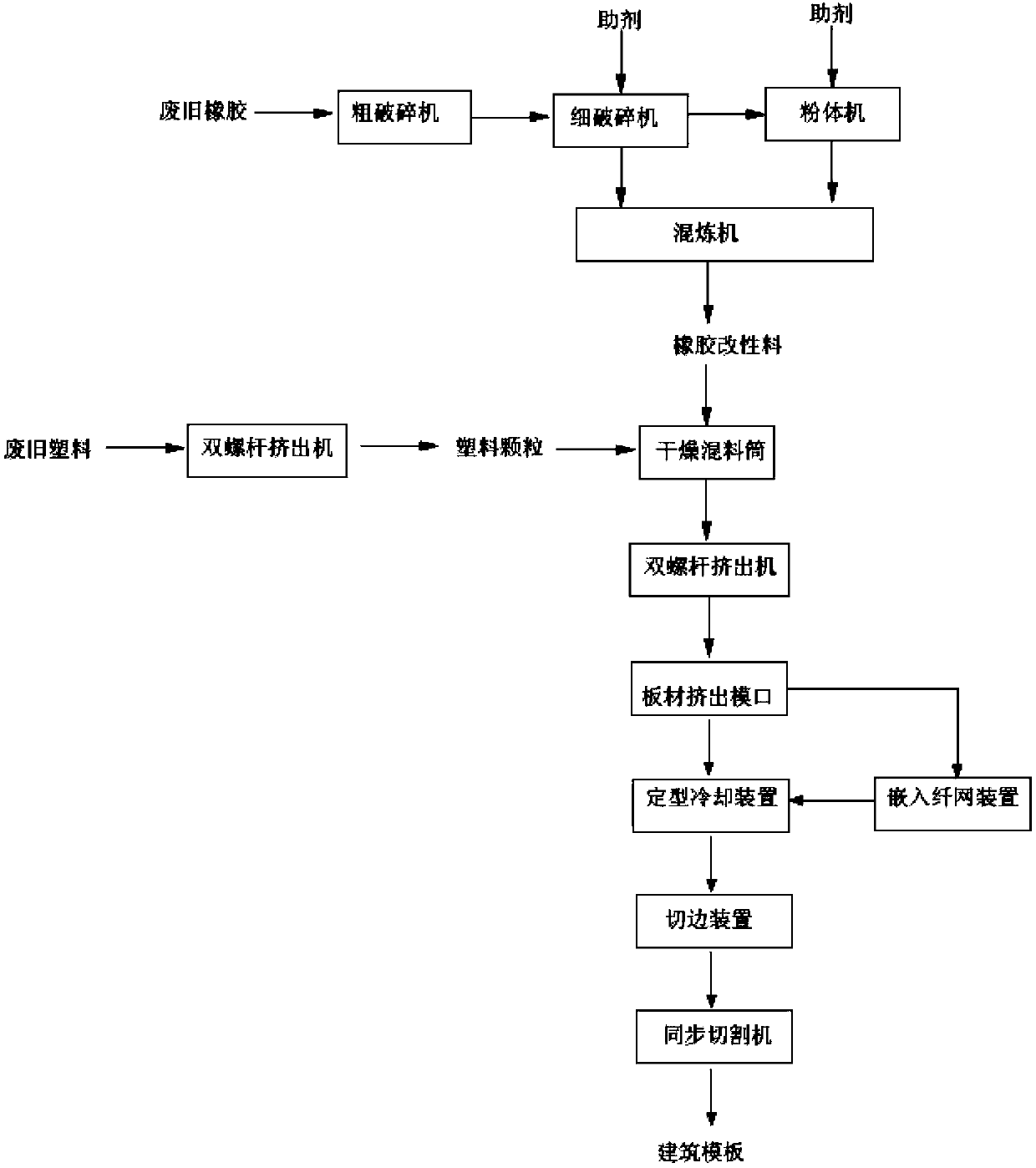Production method for high-toughness building template
A production method and technology for building formwork, applied in the field of building construction formwork, can solve problems such as poor rigidity, easy deformation, and difficult blending effects, and achieve the effects of reducing production costs, improving toughness, and improving processing fluidity
- Summary
- Abstract
- Description
- Claims
- Application Information
AI Technical Summary
Problems solved by technology
Method used
Image
Examples
Embodiment 1
[0035]The present invention is a kind of production method of high-tough building formwork, such as figure 1 Shown, this production method comprises the following steps:
[0036] S1. The waste plastic is melted, extruded, cooled, and pelletized into uniform plastic particles of regular size through a twin-screw extruder.
[0037] S2. Crushing waste rubber into micron rubber powder.
[0038] S3. Mix the rubber rubber powder with the auxiliary agent accounting for 1-15% of the rubber weight, and leave it for 0.5-24h to obtain a mixture of rubber and auxiliary agent; the auxiliary agent is composed of 10-40% adhesive, 10~40% compatibilizer, 5~20% plasticizer, 1~5% lubricant and 0~25% coupling agent. The binder is an ethylene-vinyl acetate copolymer, wherein the vinyl acetate structural unit accounts for 5-28% of the weight of the copolymer, and the compatibilizer is chlorinated polyolefin, anhydride grafted modified polyolefin One or any mixture thereof, the plasticizer is a p...
Embodiment 2
[0046] S1. The waste plastic is melted, extruded, cooled, and pelletized into uniform plastic particles of regular size through a twin-screw extruder.
[0047] S2. Use a shredder to crush the waste rubber into rubber particles with a size of 1-10mm.
[0048] S3. Mix the rubber particles and the auxiliary agent accounting for 1-15% of the weight of the rubber evenly, and let stand for 0.5-24h to obtain a mixture of the rubber particle and the auxiliary agent; the composition and content of the auxiliary agent are the same as in Example 1.
[0049] S4. The mixture of rubber and additives is mixed by mixing equipment, extruded from the machine head, and pelletized to obtain rubber modified materials with a size of 1~7cm.
[0050] S5. Measure the rubber modified material and the plastic granules according to the weight ratio of 18~35:65~82, add them into the mixing barrel, mix them evenly, and dry them at 85~90°C to obtain the rubber-plastic mixture.
[0051] S6. After the unifor...
Embodiment 3
[0056] On the basis of Example 2, this embodiment is preferred: in the step S5, chopped glass fibers are also mixed in the mixing barrel; wherein the chopped glass fibers are glass fiber leftovers or broken materials of waste glass fiber mats, The addition amount of chopped glass fiber is no more than 50% of the total weight of rubber modified material and plastic particles in the mixing barrel.
PUM
| Property | Measurement | Unit |
|---|---|---|
| size | aaaaa | aaaaa |
Abstract
Description
Claims
Application Information
 Login to View More
Login to View More - R&D
- Intellectual Property
- Life Sciences
- Materials
- Tech Scout
- Unparalleled Data Quality
- Higher Quality Content
- 60% Fewer Hallucinations
Browse by: Latest US Patents, China's latest patents, Technical Efficacy Thesaurus, Application Domain, Technology Topic, Popular Technical Reports.
© 2025 PatSnap. All rights reserved.Legal|Privacy policy|Modern Slavery Act Transparency Statement|Sitemap|About US| Contact US: help@patsnap.com

